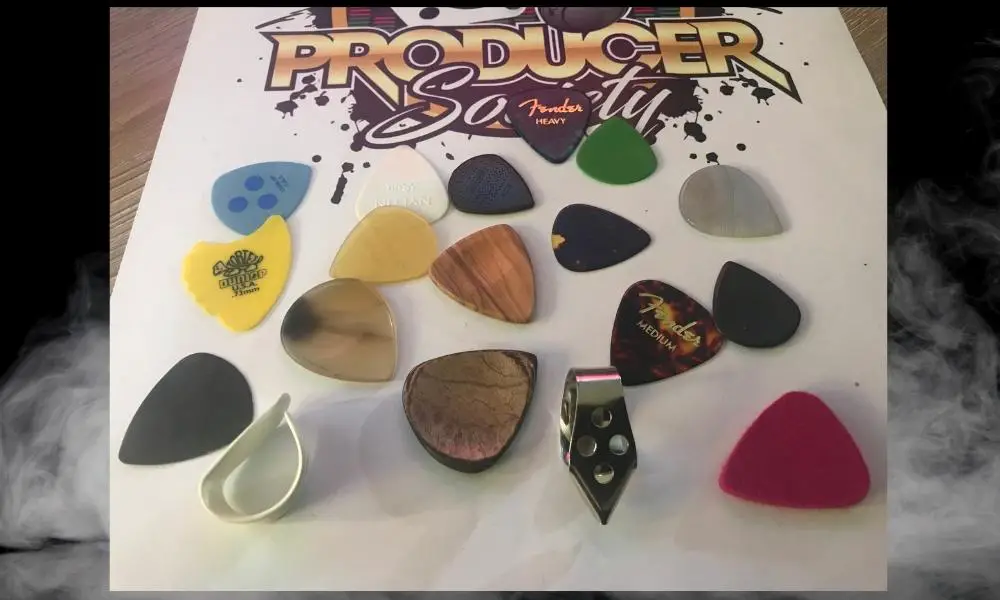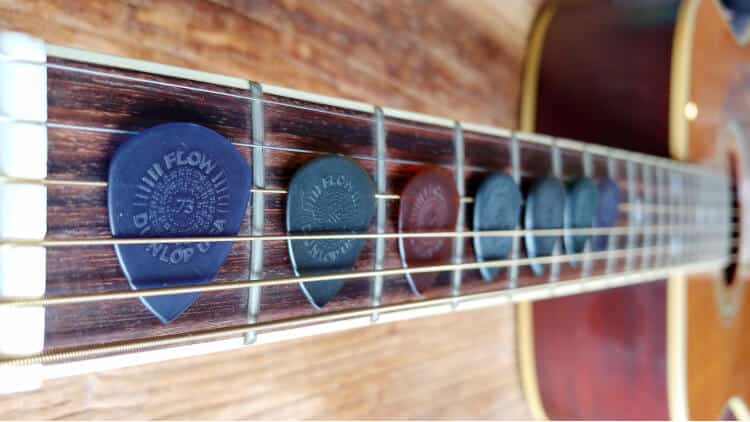Are you a passionate guitarist, looking to find the perfect acoustic guitar pick for strumming? Look no further, as this ultimate guide will provide you with all the information you need to make an informed decision. With a variety of options available, it can be overwhelming to choose the right pick for your specific playing style. From materials to thickness, we will explore the key factors to consider when selecting the best acoustic guitar pick for strumming. Whether you prefer a warm tone or a brighter sound, this guide will help you find the pick that enhances your strumming technique and ensures the best possible playing experience.

1. Types of Acoustic Guitar Picks
1.1 Thin Picks
Thin picks are commonly used for strumming acoustic guitars. They are made from materials such as plastic, nylon, or celluloid, and are known for producing a bright and crisp tone. Thin picks provide flexibility and are ideal for players who prefer a lighter touch and a more delicate sound.
1.2 Medium Picks
Medium picks strike a balance between thin and thick picks. They offer a versatile option for both strumming and picking individual strings. With a slightly heavier gauge than thin picks, medium picks provide a bit more attack and volume while maintaining some flexibility.
1.3 Thick Picks
Thick picks, also known as heavy picks, are favored by guitarists who prefer a robust and powerful sound. They are typically made from materials such as nylon or celluloid, as well as sturdier options like tortoiseshell or bone. Thick picks offer enhanced durability and control, making them well-suited for aggressive strumming or heavy-handed players.
1.4 Thumb Picks
Thumb picks are unique in their design, featuring a loop that wraps around the thumb to provide stability and control. They are commonly used in fingerstyle playing, allowing the guitarist to simultaneously strum bass notes with their thumb while picking melodies with their fingers. Thumb picks come in various sizes and materials to suit different playing styles.
1.5 Finger Picks
Similar to thumb picks, finger picks offer additional control for fingerstyle playing. They are worn on the fingertips and enable guitarists to achieve a brighter tone and greater precision when picking individual strings. Finger picks can be made from metal or plastic and come in different shapes and sizes to accommodate player preferences.
1.6 Tortex Picks
Tortex picks are a popular choice among acoustic guitarists due to their durability and versatility. Made from a synthetic material, Tortex picks offer a balanced tone with a slight edge, allowing for distinct note definition during strumming. They are available in various thicknesses to suit different playing styles.
1.7 Shell Picks
Shell picks, as the name suggests, are crafted using natural materials such as mother-of-pearl or abalone shell. They offer a unique and warm tone, often favored by jazz or blues guitarists. Shell picks are known for their smooth playing surface and comfortable grip, making them a desirable choice for strumming and intricate picking techniques.
1.8 Nylon Picks
Nylon picks are widely used and appreciated for their flexibility and versatility. They produce a warm and rounded tone that is well-suited for strumming acoustic guitars. Nylon picks also offer a comfortable grip and are less likely to slip during playing, providing a smooth and consistent strumming experience.
1.9 Carbon Fiber Picks
Carbon fiber picks are a modern alternative to traditional materials. They are known for their excellent durability, strength, and resistance to wear. Carbon fiber picks offer a bright and defined tone, making them a popular choice for strumming and aggressive playing styles. They provide a consistent attack and are less prone to breakage or chipping.
1.10 Metal Picks
Metal picks, often made from stainless steel or brass, deliver a unique and distinct tone. They offer exceptional durability and produce a bright, metallic sound while strumming. Metal picks can provide increased clarity and note definition, making them suitable for players who desire a more articulate and precise sound.
2. Choosing the Right Thickness for Strumming
2.1 Understanding Pick Thickness
Pick thickness refers to the gauge or measurement of how thin or thick a pick is. The thickness of a pick affects its flexibility, durability, and the tone it produces. Thinner picks are more flexible and produce a brighter tone, while thicker picks offer more rigidity and generate a fuller sound.
2.2 Considerations for Strumming
When choosing a pick thickness for strumming, it is crucial to consider personal playing style and musical preferences. Light strummers may prefer thinner picks for their flexibility and light touch, while heavier strummers may lean towards thicker picks to withstand their strong attack. Additionally, the type of guitar and genre of music being played can also influence the ideal pick thickness.
2.3 Pros and Cons of Different Thicknesses
Thin picks are advantageous for strumming as they produce a bright and clear tone, but they may lack volume and durability. Medium picks strike a balance between flexibility and stability, making them suitable for various playing styles. Thick picks offer enhanced volume and durability but may sacrifice some flexibility.
2.4 Recommended Thicknesses for Strumming
For strumming acoustic guitars, a medium thickness pick is often a safe choice. It provides enough rigidity for powerful strumming while maintaining some flexibility for nuanced playing. However, personal preference should always be taken into consideration, so it is recommended to try different thicknesses to find the ideal pick for one’s unique playing style.

3. Material Matters: Finding the Ideal Pick Material
3.1 Common Acoustic Guitar Pick Materials
Acoustic guitar picks are available in a variety of materials, each contributing to the tone and feel of the pick. Common materials include plastic, nylon, celluloid, tortoiseshell, bone, metal, and synthetic options like Tortex or carbon fiber.
3.2 Sound Characteristics of Different Materials
Plastic and nylon picks deliver a balanced and versatile tone suitable for various playing styles. Celluloid picks offer a warm and vintage sound reminiscent of classic guitar tones. Tortoiseshell and bone picks produce a rich and full-bodied tone, often favored by professional players. Metal picks provide a bright and metallic sound, while synthetic options like Tortex and carbon fiber offer durability and a focused tone.
3.3 Comfort and Grip
The material of a pick can significantly affect its comfort and grip. Smooth materials like nylon or plastic provide a comfortable playing experience, while textured picks offer increased grip and control. Shell picks and natural materials often have a smooth surface and offer a unique feel while playing.
3.4 Durability and Longevity
Durability is an important factor to consider when selecting a pick material. Plastic and nylon picks are generally more durable and resistant to wear, making them suitable for long-term use. Synthetic options like Tortex and carbon fiber provide exceptional durability, while natural materials like tortoiseshell or bone may require more careful handling to prevent damage.
4. Shape and Size Factors
4.1 Standard Teardrop Shape
The standard teardrop-shaped pick is the most common and widely used pick shape. It offers a versatile design that caters to different playing styles and techniques, including strumming. The rounded tip of the teardrop shape allows for smooth contact with the strings, facilitating clean strumming motions.
4.2 Pointed Picks
Pointed picks, also known as triangle picks, have a pointed tip that provides a clear and precise attack. They are favored by players seeking sharper articulation and control during strumming. Pointed picks can be useful for genres that require intricate strumming patterns or fast picking techniques.
4.3 Jazz Picks
Jazz picks feature a small and compact design. They are usually thicker and have a pointier tip, allowing for enhanced control and definition while strumming. Jazz picks are popular among jazz guitarists or players who prefer a firm grip and a bright sound.
4.4 Large Picks
Large picks, often referred to as jumbo picks, possess a larger surface area. They offer more contact with the strings and are well-suited for players who desire a fuller and more powerful tone while strumming. Large picks can also provide increased control and stability during aggressive strumming techniques.
4.5 Small Picks
Small picks, also known as stubby picks, are ideal for players who prefer a more precise and delicate touch while strumming. They offer a smaller playing surface and can be tailored to specific playing styles or genres that require intricate strumming patterns.
4.6 Custom Shapes and Designs
In addition to standard shapes, many players find unique or custom-shaped picks that cater to their individual preferences. Custom picks can offer specific benefits such as improved grip, comfort, or enhanced precision. Some players may also find unconventional shapes or designs that suit their playing style and provide a unique tonal characteristic.

5. Texture and Grip Enhancements
5.1 Smooth Picks
Smooth picks, often made from materials like plastic or nylon, provide a comfortable playing experience due to their sleek surfaces. They allow for easy glide across the strings, facilitating smooth and effortless strumming motions. Smooth picks are particularly suitable for players who require minimal friction and prefer a more relaxed strumming feel.
5.2 Textured Picks
Textured picks feature various patterns or ridges on their surface to enhance grip and control. The texture helps prevent the pick from slipping during vigorous strumming or prolonged playing sessions. Textured picks are favored by players who prefer a secure grip and increased tactile feedback while strumming.
5.3 Grip Enhancements
Grip enhancements can be in the form of coatings or materials that improve the pick’s grip and prevent slipping. Some picks are coated with rubber or a similar material to enhance friction and provide a secure hold. Others may have indentations or grooves to promote a comfortable grip. Grip enhancements are particularly beneficial for players with sweaty hands or those who engage in energetic strumming.
5.4 Personalizing Your Pick
Many companies offer customization options for picks, allowing players to personalize their picks with logos, artwork, or personalized engravings. Personalized picks can be a fun way to showcase individual style and make for great gifts or promotional items. Personalizing a pick can also have practical benefits, as it makes them easily identifiable and prevents mix-ups during band practices or performances.
6. Understanding Tone and Sound Production
6.1 Impact of Pick Material on Sound
Pick material plays a significant role in shaping the tone and sound produced by an acoustic guitar. Different materials resonate differently against the strings, resulting in variations in brightness, warmth, sustain, and overall tonal characteristics. Experimenting with different pick materials can help guitarists find the desired tone for their playing style and musical genre.
6.2 Impact of Pick Thickness on Sound
Pick thickness affects the attack, volume, and tonal response of an acoustic guitar. Thin picks produce a bright and crisp sound with a faster attack, while thicker picks generate a fuller and more rounded tone with increased volume. The choice of pick thickness should be based on personal preference and the desired sound characteristics for strumming.
6.3 Finding Your Desired Tone
Finding the desired tone involves experimentation and exploration of different pick materials, thicknesses, and playing techniques. It is important to consider personal playing style, musical genre, and the acoustic qualities of the guitar when searching for the perfect tone. Listening to recordings or seeking advice from experienced players can also provide valuable insights and inspiration.
6.4 Experimentation and Adjustments
The process of finding the ideal pick for strumming often involves experimentation and willingness to try different combinations of materials, thicknesses, and shapes. Each guitarist’s playing style, guitar setup, and musical goals are unique, and experimentation allows for a personalized and tailored approach to tone production. Making small adjustments and observing their impact on sound can lead to significant improvements in tone and overall playing experience.

7. Budget-Friendly Picks for Beginners
7.1 Affordable Picks for Novice Guitarists
Beginner guitarists often benefit from affordable picks that provide good quality at a reasonable price point. Plastic or nylon picks are widely available and offer a versatile sound suitable for strumming. Value packs that include multiple picks can provide beginners with a range of options to explore and experiment with.
7.2 Value Packs and Multi-Pick Sets
Value packs and multi-pick sets are an excellent choice for beginners who want to try out various pick types without breaking the bank. These packs often include picks of different materials, thicknesses, and shapes, allowing players to discover their preferences and develop their playing style.
7.3 Recommendations for Strumming
For novice guitarists focusing on strumming, medium thickness picks made from durable materials like plastic, nylon, or Tortex are recommended. These picks offer a good balance of flexibility and stability, allowing beginners to develop control and precision while providing a pleasant and versatile strumming tone.
8. High-End Picks for Professional Musicians
8.1 Premium Picks for Discerning Players
Professional musicians often seek high-end picks that offer exceptional quality, durability, and tonal characteristics. Custom made or handcrafted picks using premium materials such as exotic woods, precious metals, or unique composites are desirable choices for discerning players. These picks can provide a distinctive sound and unparalleled craftsmanship.
8.2 Exotic Materials and Custom Picks
Exotic materials like ivory, jade, or rare wood varieties can be used in the production of custom picks. These picks offer a luxurious feel and often produce unique tonal qualities. Professional guitarists who prioritize premium quality and personalized gear may opt for custom picks tailored to their specific preferences and playing style.
8.3 Handcrafted Picks
Handcrafted picks are typically made by skilled artisans who pay meticulous attention to detail and craftsmanship. These picks can be crafted from a variety of materials, including natural materials like wood, horn, or bone. Handcrafted picks often offer exceptional tonal qualities and are highly sought after by professional musicians and collectors.
8.4 Recommendations for Strumming
Strumming professionals may prefer picks made from premium materials such as tortoiseshell, bone, or carbon fiber. These materials provide excellent durability, a unique tonal character, and enhanced control for aggressive strumming techniques. High-end picks offer consistent performance and inspire confidence in professional musicians.

9. Finding the Perfect Pick for Your Playing Style
9.1 Fingerstyle Strumming
For fingerstyle strumming, picks like thumb picks and finger picks can offer increased control and tonal precision. Thumb picks allow for simultaneous strumming of bass notes and picking of melodies, while finger picks provide extra brightness and definition. Experimenting with different materials and shapes can help find the perfect pick for fingerstyle strumming.
9.2 Flatpicking and Aggressive Strumming
Flatpicking and aggressive strumming techniques require picks that can withstand high-impact playing and provide a full, dynamic tone. Thick picks made from durable materials like Tortex, celluloid, or metal can offer the necessary rigidity, volume, and projection for these playing styles.
9.3 Hybrid Picking
Hybrid picking combines fingerstyle techniques with the use of a pick. Guitarists who employ hybrid picking may find that medium or thin picks offer a balance between finger dexterity and pick attack. Picks with a grippy surface and comfortable grip can enhance control and facilitate ease of switching between picking and fingerstyle techniques.
9.4 Thumb Strumming Techniques
Thumb strumming techniques, often utilized in blues or folk genres, benefit from the use of thumb picks. Thumb picks provide stability and control, allowing for percussive and powerful strumming while maintaining articulation and note definition. Experimenting with different materials and sizes can help find the ideal thumb pick for thumb strumming techniques.
9.5 Personal Preference and Experimentation
Ultimately, finding the perfect pick for one’s playing style relies on personal preference and experimentation. Each guitarist has unique requirements, tonal preferences, and playing techniques that may warrant trying different pick materials, thicknesses, shapes, and designs. By experimenting and listening to the results, guitarists can discover the pick that perfectly complements their individual style and musical goals.
10. Tips for Maintaining and Caring for Your Picks
10.1 Cleaning Your Picks
Regular cleaning of picks is essential to maintain their performance and prolong their lifespan. Plastic, nylon, and other non-metal picks can be cleaned using mild soap and water. For textured or grippy picks, a toothbrush or soft-bristle brush can be used to remove any accumulated dirt or grime. Metal picks can be polished using a suitable metal cleaner or a gentle abrasive cloth.
10.2 Storage and Organization
Correct storage and organization of picks can prevent loss or damage. Using a dedicated pick holder, pick case, or pick wallet can help keep picks organized and readily accessible. Avoid exposing picks to extreme temperatures or moisture, as it may affect their structural integrity.
10.3 Preventing Wear and Tear
To prevent wear and tear, rotate the usage of picks to distribute the stress evenly. Using picks with textured surfaces or grip enhancements can reduce slippage and prevent excessive force on the pick. Avoid biting or applying excessive pressure on the pick, as it can lead to chipping or breakage.
10.4 Extending the Lifespan of Your Picks
To extend the lifespan of your picks, consider using a pick punch to repurpose broken or worn-out picks into smaller picks or other shapes. This ensures maximum utilization of each pick and reduces waste. Additionally, having multiple picks in rotation can prevent any single pick from experiencing excessive wear.
In conclusion, finding the best acoustic guitar pick for strumming involves considering various factors such as pick thickness, material, shape, texture, and personal playing style. Experimentation and a willingness to try different options are key to finding the perfect pick that enhances your strumming technique and produces the desired tone. Whether you’re a beginner or a professional musician, the right pick can greatly enhance your playing experience and unlock new musical possibilities. Remember to care for and maintain your picks to ensure their longevity and optimal performance. Happy strumming!






